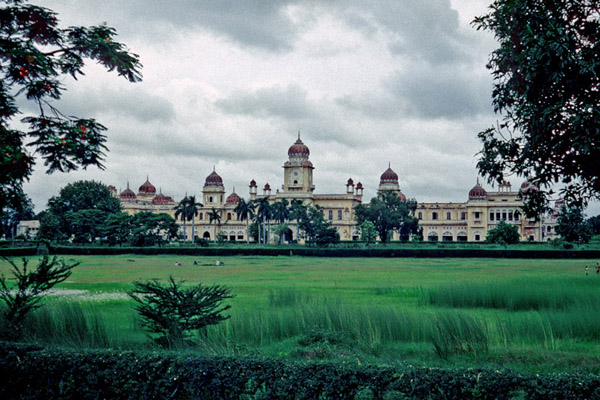|
University Of Lucknow
The University of Lucknow (informally known as Lucknow University, and LU) is a public state university based in Lucknow, Uttar Pradesh. Founded in 1920, the University of Lucknow is one of the oldest government owned institutions of higher education in India. LU's main campus is located at Badshah Bagh, University Road area of the city with a second campus at Jankipuram. LU is a teaching, residential and affiliating university, organized into more than 500 colleges and 17 institutes, located throughout the city and other surrounding areas. The University has jurisdiction over colleges of 4 districts: Raebareli, Hardoi, Sitapur and Lakhimpur Kheri. The university is opening a third campus in Sitapur district where vocational and skill development courses will be offered. The University of Lucknow is the only Public University in the State of Uttar Pradesh to be accredited with A++ status by the National Assessment and Accreditation Council. History The idea of establishing a ... [...More Info...] [...Related Items...] OR: [Wikipedia] [Google] [Baidu] |
Mahmudabad, India
Mahmudabad, (or Mahmoodabad) also known as ''Mahmudabad Awadh'' is a town and a municipal board in Sitapur district in the Indian state of Uttar Pradesh. Mahmudabad tehsil town is the main town in the mandal which has about 66 villages around, while the main city in the district is Sitapur which is about 70 km away and State Headquarter Lucknow is 52 km away. Mahmudabad is approachable by road from all the cities and towns of Uttar Pradesh, while Lucknow Airport situated about 60 km away is the nearest airport. Mahmudabad having a railway station, besides Munda Gopal Ash, Sidhauli and Ataria Railway stations are the nearest rail stations which are around 3 to 32 km distance, and some trains heading to Bihar from Delhi stop at these stations. History Mahmudabad Estate was one of the largest feudal estates in the erstwhile kingdom of Awadh. Mahmudabad is the part of Oudh State (अवध रियासत) during British India. Its raja, during the f ... [...More Info...] [...Related Items...] OR: [Wikipedia] [Google] [Baidu] |
Archaeology
Archaeology or archeology is the scientific study of human activity through the recovery and analysis of material culture. The archaeological record consists of artifacts, architecture, biofacts or ecofacts, sites, and cultural landscapes. Archaeology can be considered both a social science and a branch of the humanities. It is usually considered an independent academic discipline, but may also be classified as part of anthropology (in North America – the four-field approach), history or geography. Archaeologists study human prehistory and history, from the development of the first stone tools at Lomekwi in East Africa 3.3 million years ago up until recent decades. Archaeology is distinct from palaeontology, which is the study of fossil remains. Archaeology is particularly important for learning about prehistoric societies, for which, by definition, there are no written records. Prehistory includes over 99% of the human past, from the Paleolithic until th ... [...More Info...] [...Related Items...] OR: [Wikipedia] [Google] [Baidu] |
Institute Of Engineering And Technology
The Institute of Engineering and Technology, Lucknow (IET, Lucknow) is a state government-funded technical institute in Lucknow, Uttar Pradesh, India. It is a constituent college of Dr. A.P.J. Abdul Kalam Technical University (erstwhile Uttar Pradesh Technical University). It is popularly known as " Engineering College" in Lucknow. Undergraduate admissions until 2020 were being done through the Uttar Pradesh State Entrance Examinations SEE-UPTU, also known as UPSEE. From the session 2021-2022, Joint Entrance Examination – Main (JEE-MAIN) conducted by the National Testing Agency (NTA) replaced the UPSEE for future BTech (First Year) admissions in the College. About IET was established by the government of Uttar Pradesh in 1984, for imparting technical education. The institute is fully financed by Uttar Pradesh Government and is being administered by the Executive Committee of Dr. A.P.J. Abdul Kalam Technical University. The institute is fully residential. The institute was ... [...More Info...] [...Related Items...] OR: [Wikipedia] [Google] [Baidu] |
Canberra
Canberra ( ) is the capital city of Australia. Founded following the federation of the colonies of Australia as the seat of government for the new nation, it is Australia's largest inland city and the eighth-largest city overall. The city is located at the northern end of the Australian Capital Territory at the northern tip of the Australian Alps, the country's highest mountain range. As of June 2021, Canberra's estimated population was 453,558. The area chosen for the capital had been inhabited by Indigenous Australians for up to 21,000 years, with the principal group being the Ngunnawal people. European settlement commenced in the first half of the 19th century, as evidenced by surviving landmarks such as St John's Anglican Church and Blundells Cottage. On 1 January 1901, federation of the colonies of Australia was achieved. Following a long dispute over whether Sydney or Melbourne should be the national capital, a compromise was reached: the new capital would be b ... [...More Info...] [...Related Items...] OR: [Wikipedia] [Google] [Baidu] |
Walter Burley Griffin
Walter Burley Griffin (November 24, 1876February 11, 1937) was an American architect and landscape architect. He is known for designing Canberra, Australia's capital city and the New South Wales towns of Griffith and Leeton. He has been credited with the development of the L-shaped floor plan, the carport and an innovative use of reinforced concrete. Influenced by the Chicago-based Prairie School, Griffin developed a unique modern style. He worked in partnership with his wife Marion Mahony Griffin. In 28 years they designed over 350 buildings, landscape and urban-design projects as well as designing construction materials, interiors, furniture and other household items. Early life Griffin was born in 1876 in Maywood, Illinois, a suburb of Chicago. He was the eldest of the four children of George Walter Griffin, an insurance agent, and Estelle Burley Griffin. His family moved to Oak Park and later to Elmhurst. As a boy, he had an interest in landscape design and gar ... [...More Info...] [...Related Items...] OR: [Wikipedia] [Google] [Baidu] |
Sir George Couper, 2nd Baronet
Sir George Ebenezer Wilson Couper, 2nd Baronet, (29 April 1824 – 5 March 1908) was a British civil servant in India. Biography Couper was the eldest son of Colonel Sir George Couper, Chief Equerry and Comptroller of the Household of Princess Victoria, Duchess of Kent. His father was created a baronet in 1841. He was educated at the Royal Military Academy Sandhurst. He was sent to India in 1846 and joined the Bengal Civil Service. He was appointed a Companion of the Order of the Bath in the 1860 Birthday Honours while serving as Secretary to the Chief Commissioner of Oude, James Outram. From 26 July 1876 to 15 February 1877, he was Lieutenant-Governor of the North-Western Provinces. In 1877, he was created a Knight Commander of the Order of the Star of India and in 1878 a Companion of the Order of the Indian Empire. From 15 February 1877 to 17 April 1882, he was Lieutenant Governor of the North-Western Provinces and Chief Commissioner of Oudh. Family In 1852, he marr ... [...More Info...] [...Related Items...] OR: [Wikipedia] [Google] [Baidu] |
John Lawrence, 1st Baron Lawrence
John Laird Mair Lawrence, 1st Baron Lawrence, (4 March 1811 – 27 June 1879), known as Sir John Lawrence, Bt., between 1858 and 1869, was an English-born Ulsterman who became a prominent British Imperial statesman who served as Viceroy of India from 1864 to 1869. Early life Lawrence was born in Richmond, North Riding of Yorkshire. He was the youngest son born into a Protestant Ulster-Scots family, his mother, Letitia Knox, being from County Donegal while his father was from Coleraine in County Londonderry. Lawrence spent his early years in Derry, a city in the Province of Ulster in the northern part of Ireland, and was educated at Foyle College and Wraxhall School in Bath. His father had served in India as a soldier in the British Army and his elder brothers included Sir George Lawrence and Sir Henry Lawrence. At the age of sixteen, despite wishing for a military career like his brothers, his father enrolled him at the East India Company College, Haileybury, believin ... [...More Info...] [...Related Items...] OR: [Wikipedia] [Google] [Baidu] |
Qaisar Bagh
Qaisar ( ar, قيصر) is the Arabic version of the name Caesar and it is used as a given name in Arabia. The Roman and later Byzantine emperors were called ''Qaisar-e-Rum'' (Caesar of Rome) by the Arabs and Persians. The Ottoman Sultans also took the title '' Kayser-i Rum'' (''Caesar of Rome'', meaning the Byzantine Empire) after conquering Constantinople, modern Istanbul, on May 29, 1453. The British monarchs also used the title Kaisar-i-Hind or Emperor of India during the late 19th and early 20th-century. See also * Qaisar Bagh, "Emperor's Garden" in Lucknow, India External links Captive Roman emperorbefore the Persian Shahanshah Shapur II Shapur II ( pal, 𐭱𐭧𐭯𐭥𐭧𐭥𐭩 ; New Persian: , ''Šāpur'', 309 – 379), also known as Shapur the Great, was the tenth Sasanian King of Kings (Shahanshah) of Iran. The longest-reigning monarch in Iranian history, he reigne .... Unisex given names Arabic unisex given names Imperial titles {{name-s ... [...More Info...] [...Related Items...] OR: [Wikipedia] [Google] [Baidu] |
Isabella Thoburn College
The Isabella Thoburn College, formerly the Lucknow Women's College and often called informally IT College, is a college for women in Lucknow, India, named after its founder, Isabella Thoburn, the first woman American missionary of the Methodist Episcopal Church to sail in India 1869. The college was established in 1870 with just six girls on roll. History The origin of the college was in a school for girls opened by Isabella Thoburn on 18 April 1870 in one room in the city-centre bazaar of Lucknow There were then just six girls. By 1871, the school had expanded and moved to occupy a house named Lal Bagh, which had been lived in by the treasurer of the last Nawab of Awadh.College History at itcollege.ac.in, accessed 22 April 2012 On 12 July 1886 Miss Thoburn's school was renamed as the Lucknow Women's College and began to teach < ... [...More Info...] [...Related Items...] OR: [Wikipedia] [Google] [Baidu] |
King George's Medical University
King George's Medical University is a medical school, hospital, and medical university located in Lucknow, Uttar Pradesh, India. The medical school was raised to a medical university by an act passed by the government of Uttar Pradesh on 16 September 2002. The university has about 1250 undergraduate students (including 280 dental students) and 450 postgraduate students. About 250 students a year are admitted to the four-and-a-half-year course of study for the degree of M.B.B.S. History King George V, then the Prince of Wales, laid the foundation stone of King George's Medical College in 1906. The college opened its gates in 1911, though the official opening ceremony was delayed to January 1912. The college was directly under the Government of the United Provinces, and degrees were awarded through Allahabad University. In 1921, the college was transferred to Lucknow University. In 2002 the Government of Uttar Pradesh, led by Mayawati of the Bahujan Samaj Party (BSP), granted ... [...More Info...] [...Related Items...] OR: [Wikipedia] [Google] [Baidu] |

.jpg)





